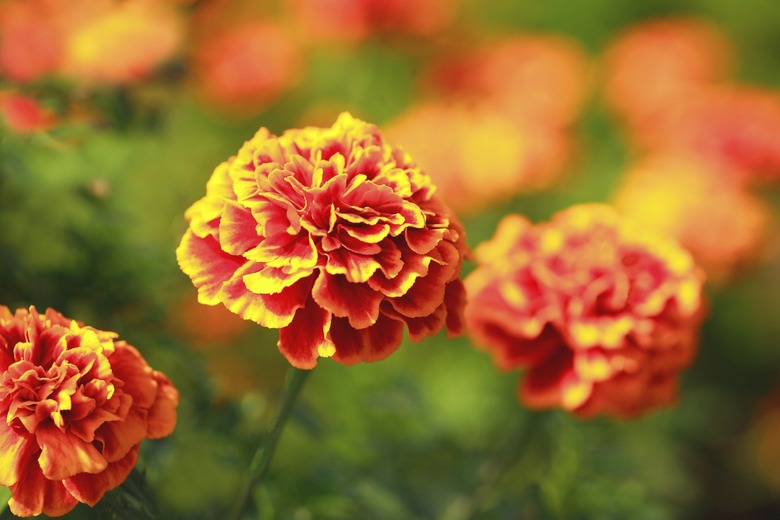What Is Eating My Marigolds?
While the pungent aroma and taste of marigolds (Tagetes spp.) wards off many unwanted garden pests, some insects aren't put off by the bitterness, and several diseases don't discriminate between the types of plants they infect. Chewed, yellowed or wilting leaves, powdery substances on stems and petioles, and holes in leaves and blossoms are clear indicators that something is not quite right in marigold-land.
Hungry Insects
Of the several species of aphids, those that attack marigolds include the dark gray bean aphid, the green peach aphid and the yellow to greenish-yellow melon, or cotton, aphid. While the destructive insects sometimes occur singly on plants, they are more commonly found in clusters along the undersides of leaves and stems. Large numbers of aphids produce a sticky substance called honeydew, and they can cause marigold leaves to turn yellow and stunt new growth. Spider mites are tiny pale green insects that live in colonies beneath leaves and often spin webs along leaf stems. Damage includes small holes in the leaves where the mites feed, which in severe cases causes leaves to turn yellow or red and fall off. Damage caused by thrips, tiny winged insects with almost translucent bodies, includes stunted growth of marigold plants and misshapen leaves.
- While the pungent aroma and taste of marigolds (Tagetes spp.)
- Large numbers of aphids produce a sticky substance called honeydew, and they can cause marigold leaves to turn yellow and stunt new growth.
Fungal Diseases
Diseases that affect marigolds are often caused by molds and fungi that develop in the soil and are transmitted from plant to plant. Like insects, fungi are living organisms that feed on plant matter, causing the tissues in leaves and stems to wilt, and that often results in the death of the plants. Botrytis blight (Botrytis cinerea) causes spotting and discoloration of flowers; the marigold buds rot before they even open, and leaves become discolored, rot and fall off. Root and crown rot of marigold plants caused by several different fungi produce stunted growth, soft darkened stems that break off and wilting of entire plants. Leaf spots in the form of yellow of brownish raised lesions cause leaves to fall off, while verticillium wilt causes leaves to turn yellow, tan or brown from the bottom of the marigold plants and up, resulting in death.
Solutions and Prevention
Environmentally conscious methods of marigold plant pest control include destroying all affected plant parts and flushing small insects such as spider mites, aphids and thrips with a strong stream of water from the garden hose. For more severe infestations, spray all parts of the plants with a solution of neem, a horticultural oil that smothers the insects. In a spray bottle, mix 1 teaspoon of neem oil with about 1/2 teaspoon of dish detergent or insecticidal soap with 1 quart of warm water. Mix thoroughly and apply to the entire marigold plant at the first sign of problems and once a week until no sigh remains of the pests. Do not apply insecticidal soap when the temperature is above 90 degrees Fahrenheit. Treat fungal diseases by mixing 1/2 to 2 ounces of liquid copper fungicide concentrate with 1 gallon of water, and spray all parts of the plant at first sign of infection and every seven to 10 days as long as necessary. Wear gloves, protective clothing and observe label safety cautions when mixing or applying garden chemicals.
- Diseases that affect marigolds are often caused by molds and fungi that develop in the soil and are transmitted from plant to plant.
- For more severe infestations, spray all parts of the plants with a solution of neem, a horticultural oil that smothers the insects.
Marigold Culture
Marigolds can be grown year-round as perennials in U.S. Department of Agriculture plant hardiness zones 9 to 11, and elsewhere as warm-season annuals. According to the University of California, Davis, many insect and fungal pests can be prevented with good gardening practices that include proper watering, providing proper sunlight and air circulation and keeping the area weed-free. When watering marigolds, wet the soil rather than the plants, and allow any excess water to drain off, since chronically damp soil invites disease in plants that have been weakened by insect damage. Keep the plants trimmed of all diseased or damaged parts, and aerate the soil around them periodically to prevent any potential insect colonies from forming.
